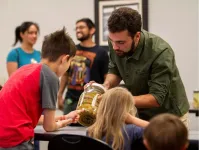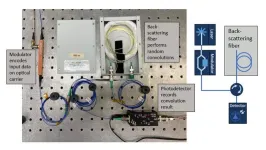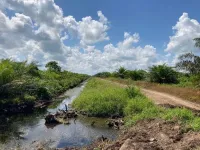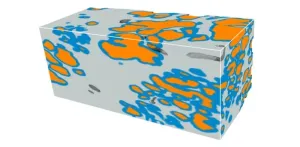(Press-News.org) With the help of 16 grants from the National Science Foundation, researchers have painstakingly taken computed topography (CT) scans of more than 13,000 individual specimens to create 3D images of more than half of all the world's animal groups, including mammals, fishes, amphibians and reptiles.
The research team, made of members from The University of Texas at Arlington and 25 other institutions, are now a quarter of the way through inputting nearly 30,000 media files to the open-source repository MorphoSource. This will allow researchers and scholars to share findings and improve access to material critical for scientific discovery.
“Thanks to this exciting openVertebrate project, also called oVert, anyone—scientists, researchers, students, teachers, artists—can now look online to research the anatomy of just about any animal imaginable without leaving home,” said Gregory Pandelis, collections manager of UT Arlington’s Amphibian and Reptile Diversity Research Center. “This will help reduce wear and tear on many rare specimens while increasing access to them at the same time.”
A summary of the project has just been published in the peer-reviewed journal BioScience reviewing the specimens that have been scanned to date and offering a glimpse of how the data might be used in the future.
For example, one research team has used the data to conclude that Spinosaurus, a massive dinosaur that was larger than Tyrannosaurus rex and thought to be aquatic, would have actually been a poor swimmer, and thus likely stayed on land. Another study revealed that frogs have evolved to gain and lose the ability to grow teeth more than any other animal.
The value of oVert extends beyond scientific inquiry. Artists are using the 3D models to create realistic animal replicas. Photographs of oVert specimens have been displayed as part of museum exhibits. In addition, specimens have been incorporated into virtual reality headsets that allow users to interact with the animals.
Educators also are able to use oVert models in their classrooms. From the outset of the project, the research team placed a strong emphasis on K-12 outreach, organizing workshops where teachers could learn how to use the data in their classrooms.
“As a kid who loved all things science- and nature-related and had a particular interest in skeletal anatomy, I would go through great pains to collect, preserve and study skulls and other specimens for my childhood natural history collection, the start of my scientific inspiration,” Pandelis said. “Realizing that you could study these things digitally with just a few clicks on a computer was eye-opening for me, and it opened up the path to my current research using CT scans of snake specimens to study their skull evolution. Now, this wealth of data has been opened and made publicly accessible to anyone who has a professional, recreational or educational interest in anatomy and morphology. Natural history specimens have never been so accessible and impactful.”
In the next phase of the research project, the team will be creating sophisticated tools to analyze the data collected. Since researchers have never had digital access to so many 3D natural history specimens before, it will take further developments in machine learning and supercomputing to use them to their full potential.
For a video snapshot of the project, watch this two-minute video.
END
Natural history specimens have never been so accessible
UTA part of project to make 3D images of 13,000 vertebrates available free online
2024-03-11
ELSE PRESS RELEASES FROM THIS DATE:
NRL research physicists explore fiber optic computing using distributed feedback
2024-03-11
WASHINGTON – U.S. Naval Research Laboratory (NRL) researchers deliver novel contribution in fiber optics computing, Fiber Optic Computing Using Distributed Feedback paper recently published in Communications Physics journal, brings the Navy one step closer to faster, more efficient computing technologies.
Optical computing uses the properties of light, such as its speed and ability to carry large amounts of data, to process information more efficiently than traditional electronic computers.
In collaboration with Sandia National Laboratories and the University of Central Florida, NRL is aiming ...
Canals used to drain peatlands are underappreciated hotspots for carbon emissions
2024-03-11
A new study led by UC San Diego Scripps Institution of Oceanography postdoctoral scholar Jennifer Bowen finds that canals used to drain soggy peatlands in Southeast Asia are likely hotspots for greenhouse gas emissions.
The results, published March 8 in Nature Geoscience and supported by the Scripps Institutional Postdoctoral Program and Stanford University’s Precourt Institute for Energy, identify a previously unaccounted for source of emissions from these threatened, carbon-rich landscapes. Findings from the study suggest that the degradation of tropical peatlands in Southeast Asia has released even more planet-warming ...
Nutritional value of meat should be considered when comparing carbon footprints
2024-03-11
The nutritional value of meat must be considered when comparing carbon footprints – that is the key message from a recent study undertaken by Hybu Cig Cymru – Meat Promotion Wales (HCC), Bangor University, Queen’s University, and the Agri-Food and Biosciences Institute (AFBI).
The scientific paper, published in the journal Frontiers in Sustainable Food Systems using data from the Welsh Lamb Meat Quality project, focuses on different lamb production systems, specifically the ‘finishing’ period – at the end of which lambs have reached the required weight, meat and fat cover for ...
Microscopy plus deep learning to advance prostate cancer diagnosis
2024-03-11
Prostate cancer stands as a prevalent threat to men's health, ranking second in cancer-related deaths in the United States. Each year, approximately 250,000 men in the U.S. receive a prostate cancer diagnosis. While most cases have low morbidity and mortality rates, a subset of cases demands aggressive treatment. Urologists assess the need for such treatment primarily through the Gleason score, which evaluates prostate gland appearance on histology slides. However, there's considerable variability in interpretation, leading to both undertreatment and overtreatment.
The current method, based on histology ...
Cancer researchers awarded $3.2 million grant to find better ways to treat advanced melanoma
2024-03-11
A team of investigators from the UCLA Health Jonsson Comprehensive Cancer and the University of Arkansas for Medical Sciences (UAMS) Winthrop P. Rockefeller Cancer Institute was awarded a $3.2 million grant from the National Institutes of Health to identify new ways to prevent and overcome treatment resistance to targeted therapy in patients with all sub-types of cutaneous melanoma, an aggressive form of skin cancer.
Virtually all cutaneous melanomas display genetic alterations that ...
The liver immune system eats up ‘bad cholesterol’
2024-03-11
A new study from Karolinska Institutet in Sweden reveals that immune cells in the liver react to high cholesterol levels and eat up excess cholesterol that can otherwise cause damage to arteries. The findings, published in Nature Cardiovascular Research, suggest that the response to the onset of atherosclerosis begins in the liver.
Cholesterol is a type of fat that is essential for many functions in the body, such as making hormones and cell membranes. However, too much cholesterol in the blood can be harmful, as it can stick to the walls of the arteries ...
New study finds female entrepreneurs do better with guidance from female mentors
2024-03-11
INFORMS Journal Marketing Science Study Key Takeaways:
Female entrepreneurs increase their chances of success and improved performance with female mentors.
One of the key benefits to female entrepreneurs is a mentoring style characterized as “positive engagement.”
BALTIMORE, MD, March 11, 2024 – In business and in life, the power of mentorship has long been understood, but how important is it that your mentor look like you? This question was at the center of a new study, which specifically found that mentor gender has a powerful impact on ...
Using wrist-worn activity trackers to help patients reduce long COVID symptoms
2024-03-11
LA JOLLA, CA—Scientists at the Scripps Research Digital Trials Center have partnered with the health technology company CareEvolution to launch a remote study that will investigate whether wrist-worn devices, such as activity trackers and smartwatches, can help people with long COVID manage and reduce the severity of their symptoms.
“New treatments and interventions are urgently needed,” says the study principal investigator Julia Moore Vogel, PhD. “We’re excited to launch the Long COVID Wearable Study and ...
AI-generated food images look tastier than real ones
2024-03-11
With the Global Nutrition and Hydration Week 2024 starting today, researchers have announced an intriguing discovery – consumers generally prefer AI-generated images of food over real food images, especially when they are unaware of their true nature. The new findings have been published in Food Quality and Preference.
According to the researchers, the results suggest that AI-generated food visuals excel at enhancing the appeal of depicted foods by leveraging key features such as symmetry, shape, glossiness, and overall lighting and colour. All of these are known to contribute significantly ...
Implantable brain-computer interface collaborative community (iBCI-CC) to drive innovation in neurotechnology
2024-03-11
BOSTON – (March 11, 2024) Mass General Brigham is establishing the Implantable Brain-Computer Interface Collaborative Community (iBCI-CC). This is the first Collaborative Community in the clinical neurosciences that has participation from the U.S. Food and Drug Administration (FDA).
BCIs are devices that interface with the nervous system and use software to interpret neural activity. Commonly, they are designed for improved access to communication or other technologies for people with physical disability. Implantable BCIs are investigational devices ...
LAST 30 PRESS RELEASES:
Mount Sinai Health system receives $8.5 million NIH grant renewal to advance research on long-term outcomes in children with congenital heart disease
Researchers develop treatment for advanced prostate cancer that could eliminate severe side effects
Keck Medicine of USC names Christian Pass chief financial officer
Inflatable fabric robotic arm picks apples
MD Anderson and SOPHiA GENETICS announce strategic collaboration to accelerate AI-driven precision oncology
Oil residues can travel over 5,000 miles on ocean debris, study finds
Korea University researchers discover that cholesterol-lowering drug can overcome chemotherapy resistance in triple-negative breast cancer
Ushikuvirus: A newly discovered giant virus may offer clues to the origin of life
Boosting the cell’s own cleanup
Movement matters: Light activity led to better survival in diabetes, heart, kidney disease
Method developed to identify best treatment combinations for glioblastoma based on unique cellular targets
Self-guided behavioral app helps children with epilepsy sleep earlier
Higher consumption of food preservatives is associated with an increased risk of type 2 diabetes
NTU Singapore-led team captures first-ever ‘twitch’ of the eye’s night-vision cells as they detect light, paving the way for earlier detection of blindness-causing diseases
Global aviation emissions could be halved through maximising efficiency gains, new study shows
Fewer layovers, better-connected airports, more firm growth
Exposure to natural light improves metabolic health
As we age, immune cells protect the spinal cord
New expert guidance urges caution before surgery for patients with treatment-resistant constipation
Solar hydrogen can now be produced efficiently without the scarce metal platinum
Sleeping in on weekends may help boost teens’ mental health
Study: Teens use cellphones for an hour a day at school
After more than two years of war, Palestinian children are hungry, denied education and “like the living dead”
The untold story of life with Prader-Willi syndrome - according to the siblings who live it
How the parasite that ‘gave up sex’ found more hosts – and why its victory won’t last
When is it time to jump? The boiling frog problem of AI use in physics education
Twitter data reveals partisan divide in understanding why pollen season's getting worse
AI is quick but risky for updating old software
Revolutionizing biosecurity: new multi-omics framework to transform invasive species management
From ancient herb to modern medicine: new review unveils the multi-targeted healing potential of Borago officinalis
[Press-News.org] Natural history specimens have never been so accessibleUTA part of project to make 3D images of 13,000 vertebrates available free online




